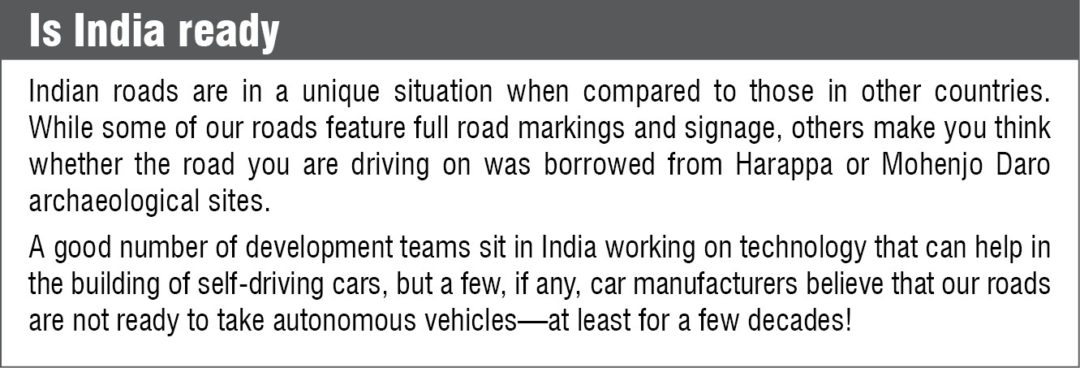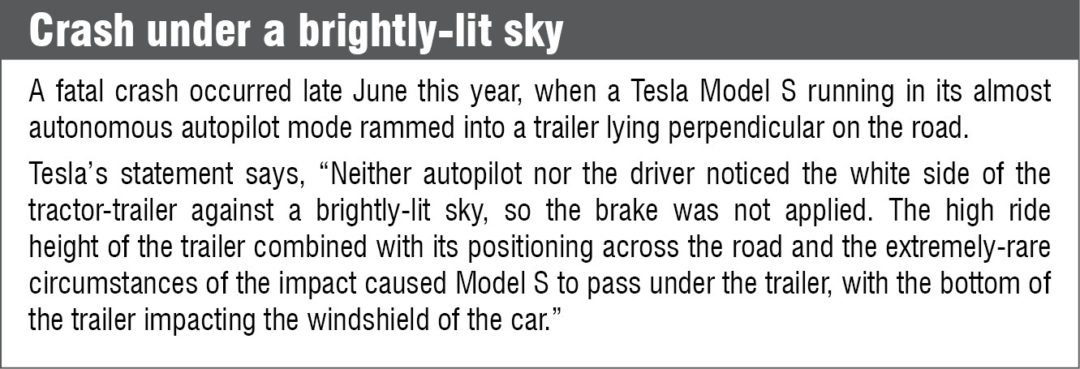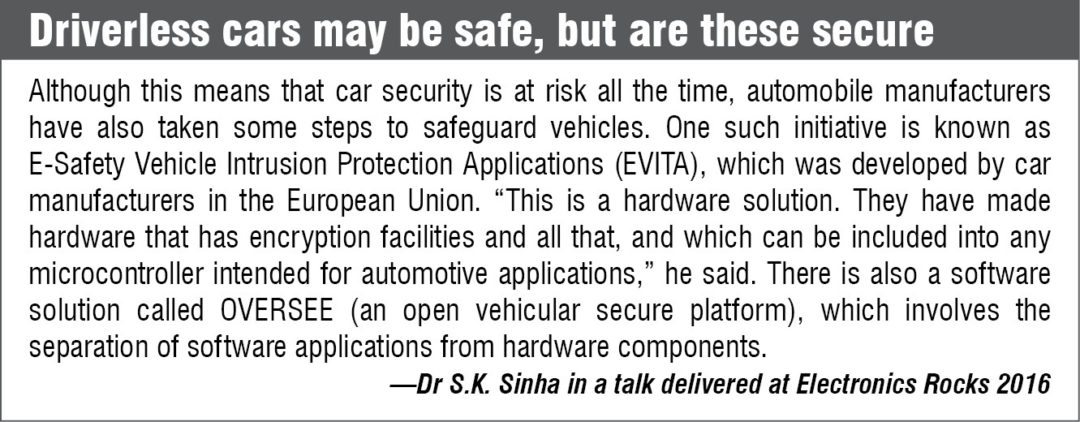People are, on average, terrible drivers. How do you solve this problem? Do not let them drive or put a machine in its place?
Self-driving vehicles are not some futuristic automotive technology that we are yet to see. These are cars from the likes of BMW and Tesla with self-driving features on the road. There are two types that are being tested or that are on the road: semi-autonomous cars that we already see and fully autonomous ones that are expected anywhere between two to 14 years depending on whom you ask. Tesla CEO Elon Musk and Google’s Sergey Brin are two people who believe that it will be sooner rather than later.
Chris Urmson, who heads Google’s driverless car programme, said in a talk, “My oldest son is 11, and that means in four and a half years he will be eligible to get a driver’s licence. My team and I are committed to make sure that does not happen.”
So when these arrive, what would enable cars to safely roam our streets by themselves?
Sense of sight
In order for your car to be aware of its surroundings, it first needs to see where it is standing.
LiDAR. LiDAR, or Light Detection And Ranging, is one of the most popular and actively-used technologies that enable self-driving cars to see. The most recognised version of LiDAR is the one you see on top of Google’s self-driving cars, and it is HDL-64E.
Velodyne’s HDL-64E enables obstacle detection and navigation with a 360° field-of-view.
Enabled by 64 laser beams, this is probably one of the best and most expensive solutions available right now.
Another firm, Quanergy, recently announced a solid-state LiDAR named S3 that has no moving parts or micro-mirrors. Instead, it uses an optical-phased array as a transmitter, which can steer pulses of light by shifting the phase of a laser pulse as it is projected through the array. S3 is due to be available in September.

The major benefit of using LiDAR systems is that the data these generate is easier to compute and process as compared to the data generated from a camera. These can also work in places where GPS and mapping data are not really accurate. Volvo Group has an autonomous FMX heavy-duty vehicle designed to work in underground mines without the need for a driver.
Of all the demonstrations that we at EFY have come across of LiDAR usage, perhaps the best is when the car picks up a cyclist waiting to cross the road on the other side of a pickup truck. Drivers in the car are not able to see the cyclist, but LiDAR laser picks it up, calculates the distance and prevents the car from moving ahead until the cyclist has passed.
Cameras. Mercedes F015, about which we wrote last year, does not use LiDAR, but a mix of 3D stereoscopic cameras, radars and ultrasonic sensors for its autonomous functions. It is very much possible to set up driver-assistance systems using just camera data, like how Land Rover Discovery Sport does with a Bosch stereo video camera. Its spatial measurements and video signals provide enough data to calculate, for example, the distance to vehicles ahead.
This is nothing new, of course, as Subaru has been marketing their own version since 2010, and Continental has their own forward-looking braking system with stereoscopic cameras that is just as old.

Infrared or thermal imaging cameras have been available that can detect hidden objects like people or animals in total darkness, smoke or fog-like conditions when normal detection systems may not easily pick these up. FLIR Systems PathFindIR is a compact thermal imaging camera that significantly reduces the hazards of night time driving, and is designed for both military vehicles as well as commercial vehicles as an aftermarket part. These systems have improved from mere night vision to being able to identify a hazardous object or even go as far as alerting the object.
Mercedes had CL550 a few years back that would identify pedestrians on the road and flash them with four blasts of diverted headlight while highlighting them with white brackets on users’ screens.
While LiDAR and cameras are great for generating an accurate map of the car’s surroundings, these are not ideal for monitoring the speed of other moving objects in real-time. So what do we do?
Sense of hearing
Just like Tesla, which uses radar as one among its suite of electronic senses with which the car finds its way around town, there are other vendors too who plan to use automotive radar.
Radar. CMOS seems to be the in thing in the world of automotive radar. NXP has millimetre-wave technology for its automotive radar, which is based on a digital CMOS process that was not believed possible. The solution covers 76GHz to 81GHz range.
Imec and Vrije Universiteit Brussel from Belgium announced some time back what they then claimed to be the world’s first 79GHz radar transmitter based on digital 28nm CMOS. “With an output power above 10dBm, the transmitter front-end paves the way for full radar-on-chip solutions for automotive and smart environment applications,” stated the release.
Freescale has a 77GHz packaged radar front-end chipset but they use SiGe technology.
Infineon’s SiGe based Radar System IC (RASIC) series consists of a group of highly-integrated functions for 76GHz to 77GHz range for automotive radar.
GPS, V2X and everything else. While these are more for speaking than merely listening, GPS and V2X enable an intelligent transport system where all vehicles and infrastructure systems are interconnected with each other. This connectivity aims to provide more precise knowledge of the traffic situation across the entire road network.
Continental has been at it since 2006. Their system can be complemented by the intelligent localisation sensor M2XPro or Motion Information to X Provider. Fusion of sensor data about speed, steering angle, GNSS and inertial information, along with position and timing information are essential for V2X communication to detect and evaluate potential threats. This enables a perception, detection and assessment of road obstacles and dangerous situations even before these can be noticed optically.
The standardised frequency band of 5.9GHz (IEEE 802.11p) derived from Wi-Fi as the technology base for wireless communication enables direct, low-latency information exchange between vehicles and infrastructure. IEEE 1609 family of standards for Wireless Access in Vehicular Environments (WAVE) defines the architecture, communications model, management structure, security mechanisms and physical access for high-speed (up to 27Mb/s), short-range (up to 1000m), low-latency wireless communications in the vehicular environment.
Primary architectural components defined by these standards are OnBoard Unit (OBU), Road Side Unit (RSU) and WAVE interface. Dedicated Short-Range Communication (DSRC) is a communication technology that works in the 5.9GHz band in the USA and China or 5.8GHz band in Japan and Europe.
ST has a V2X system using their co-developed Autotalks V2X Communication processor along with ST’s multi-constellation GNSS receiver, Teseo, that builds a perfect match to ensure a precise positioning accuracy, low latency and dead reckoning.
U-blox lists an automotive-grade V2X transceiver module called THEO-P1 series for infrastructure and vehicles, which is in compliance with WAVE and ETSI ITS G5 for American and European operations. U-blox claims that this chip has a range of one kilometre.
Sense of awareness
While having cameras to see details on the road are important, those that come with processing software to pick up lane markers and monitor your distance from these are what enable cars and other vehicles to drive themselves. If you stray over the line without signalling, you will hear a warning tone or feel a physical alert such as a vibration in the steering wheel or seat. More advanced lane-keeping assist systems selectively apply brakes or nudge the steering to guide you back if you are wandering.
- In autonomous mode, such as in Tesla with autopilot, a front-facing radar, a camera with image-recognition capability and 360-degree ultrasonic sonar will pick up lane markings on the road as well as other vehicles to steer and control vehicle speed.

In a talk delivered at Electronics Rocks 2016 conference, Dr S. K. Sinha said, “Thirty years ago, software in the cars was zero—there was no software. And, in just a short period of 30 years, the amount of software has gone to ten million lines of code, in low-end cars. If you talk about Audi, Mercedes or BMW cars, these have hundred million lines of code today. Thousands of functions are being realised with software today.”
“The biggest worry is if the software controlling the cars have enough information about the world around it and how it reacts to situations,” says Sanjay Gupta, India country manager, NXP India. NXP has four broad umbrellas, that is, sense, think, act and Big Data. Radar, vision and secure V2X help the vehicle in its sensing capabilities. The self-driven car thinks on processing, sensor fusion and security, and acts through power-train, chassis and braking. Big Data comes in the picture to provide necessary infrastructure, security and digital networking.
Even when these vehicles are capable of fully-autonomous driving, it might take quite some time for it to show up on highways until the necessary legislation and policies are passed. In the meanwhile, mines and other closed industrial areas are ripe for a disruptive transportation technology that can remove the unpredictability of humans while simultaneously reducing danger to humans working in dangerous locations such as mines.
NFC and the Ethernet, in cars
NFC is now playing a role in automotive because of mobiles that are starting to adopt NFC, and we know the importance of mobiles and how convenient these are. “Automotive is picking up NFC because an automobile can have multiple people sitting in it and NFC is more convenient,” said Rajiv Kapur, managing director, Broadcom India, in an interview with EFY.

The whole universe of the Ethernet had previously been outside the car. Automotive world had not touched the Ethernet world until now. The first vehicle on the streets in the world to use the Ethernet in it was BMW X6.
The whole purpose is to leverage the universe of the Ethernet to give better vehicles. For example, the rear camera can be an Ethernet based camera. Kapur added, “We actually invented how the Ethernet can be distributed over thin cables. It is a standard now but we invented it. Once the automobile industry got that invention, which is now a standard, it started to adopt it. Now there are many more vehicles with the Ethernet in them.”
Your car will have a licence to kill
A new study published in Science shows that people want self-driving cars to be programmed to minimise casualties during a crash, even if it causes the death of the rider. Trouble is, the same survey shows that people do not actually want to ride in cars that are programmed this way. That is obviously a problem, and we are just going to have to get over it!
Dilin Anand is a senior assistant editor at EFY. He is B.Tech in ECE from University of Calicut, and MBA from Christ University, Bengaluru








